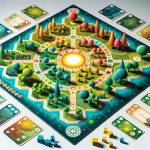Board Game Photosynthesis Strategy is a comprehensive guide that delves into the world of strategic gameplay in the popular board game, Photosynthesis. In this captivating game, players take on the role of tree spirits, competing for sunlight and strategically growing their trees to collect resources. With stunning visuals and intuitive mechanics, Photosynthesis has gained a dedicated following among board game enthusiasts worldwide.
Strategy plays a crucial role in achieving victory in Photosynthesis. From understanding the core mechanics to analyzing different strategies, this article will provide valuable insights and tips for players looking to enhance their gameplay. By employing effective placement of trees and efficient resource management, players can maximize their chances of success.
In this guide, we will explore various tactics and techniques utilized by successful players of Photosynthesis. We will delve into advanced strategies that go beyond conventional gameplay, such as manipulating opponents’ moves and utilizing mind games. Furthermore, real-life case studies from expert players will be featured to offer further inspiration and guidance.
So whether you are a beginner seeking an introduction to strategic gaming or an experienced player looking to refine your approach, grab your seed tokens and prepare to immerse yourself in the fascinating world of Board Game Photosynthesis Strategy. Discover how thoughtful planning and calculated decision-making can propel you towards victory in this visually stunning and tactically engaging tabletop adventure.
Overview of Photosynthesis
The board game Photosynthesis has gained significant popularity among board game enthusiasts due to its unique gameplay mechanics and engaging objective. In this section, we will provide a brief overview of the game, including its objective and gameplay mechanics, as well as discuss its popularity within the board game community.
Photosynthesis is a strategic board game designed for 2 to 4 players. The objective of the game is to grow and manage a forest by strategically placing tree tokens on the hexagonal board. The goal is to collect sunlight points represented by tokens that are placed on the board, which can be used to develop and grow your trees. The player who accumulates the most points by the end of the game wins.
The gameplay mechanics in Photosynthesis revolve around resource management and spatial positioning. Each turn, players can either plant a seed or grow a tree, depending on their available resources and strategic objectives. Sunlight plays a crucial role in the game as it determines which trees receive energy for growth. As trees grow taller, they cast shadows that block sunlight from reaching other players’ trees, making strategic placement and blocking key aspects of gameplay.
This unique combination of resource management, spatial positioning, and strategic decision-making has garnered attention from both casual gamers and avid board game enthusiasts alike. Players appreciate the elegant simplicity of the rules combined with deep and thoughtful gameplay choices. The visually stunning components and immersive theme further contribute to its appeal. With numerous nominations and awards under its belt, Photosynthesis has solidified itself as an enjoyable and engaging strategy game within the board gaming community.
| Number of Players | 2-4 |
|---|---|
| Playing Time | 30-60 minutes |
| Complexity | Medium |
| Average Rating | 8.0/10 |
As you can see, Photosynthesis offers a balanced gameplay experience that can be enjoyed by both casual and experienced players. Its intuitive mechanics and visually appealing components make it an attractive choice for strategy game enthusiasts looking for a unique, immersive experience.
Understanding the Basic Mechanics
Photosynthesis is a board game that revolves around the concept of growing trees, harnessing sunlight, and managing resources effectively. In order to develop a successful strategy in the game, it is crucial to understand its core mechanics.
The primary objective of Photosynthesis is to earn the highest possible amount of points by strategically growing and harvesting trees. The game is played over several rounds, with each round representing a cycle of day and night. During the day, players gain sunlight points based on the position of their trees on the board.
Sunlight points are essential for tree growth and determining turn order. On the other hand, during the night phase, players use their stored sunlight points to perform various actions such as planting seeds or harvesting mature trees.
Tree growth in Photosynthesis follows a unique mechanic where young sapling trees grow into medium-sized and eventually large-sized trees as they receive more sunlight throughout subsequent rounds. The larger the tree size, the higher its output for absorbing sunlight, which can be crucial for generating resources.
Sunlight plays a vital role in Photosynthesis as it not only fuels tree growth but also influences turn order. Players with higher accumulated sunlight points have an advantage during gameplay as they get to take their turns earlier than others. This aspect adds a layer of strategy as players must balance maximizing resource generation through sunlight absorption with timing their actions strategically.
In addition to understanding tree growth and sunlight mechanics, mastering resource management is key in Photosynthesis. The game features a unique resource management system where players earn different types of resources based on their tree placement on the board and time of harvest. Seeds are earned when small or medium-sized trees are harvested while valuable advancements are gained through harvesting large-sized trees at specific locations.
By comprehending these basic mechanics – tree growth, importance of sunlight, and resource management system – players can begin formulating strategic approaches to optimize their gameplay. Whether it’s focusing on rapid tree growth or prioritizing earning advancements, a solid understanding of the core mechanics paves the way for successful decision-making in Photosynthesis.
| Core Mechanics | Description |
|---|---|
| Tree Growth | Trees grow from saplings to large-sized trees based on sunlight absorption. |
| Sunlight | Players earn sunlight points and use them for tree growth and turn order. |
| Resource Management System | Earning seeds and advancements through strategic tree placement and harvesting. |
Analyzing the Different Strategies
In Photosynthesis, there are several different strategies that players can use to increase their chances of winning the game. Each strategy has its own advantages and disadvantages, and success will depend on how well players adapt to changing circumstances and opponents’ moves.
- Sunlight Rush Strategy: One popular strategy in Photosynthesis is the “Sunlight Rush.” This strategy focuses on quickly growing tall trees to cover as much ground as possible to absorb sunlight points. By emphasizing quick growth, players can gain a significant advantage early in the game. However, this strategy requires careful planning for future turns, as tall trees will eventually cast large shadows over smaller ones, limiting their access to sunlight.
- Shadow Deliberation Strategy: Another approach is the “Shadow Deliberation” strategy. This tactic involves strategically blocking opponents’ access to sunlight by deliberately placing your trees in positions that cast shadows on their trees. This strategy works best when combined with tree placement that ensures maximum sunlight absorption for oneself. While this approach may slow down your own growth initially, it can significantly hinder your opponents’ progress and give you an edge later in the game.
- Balanced Expansion Strategy: A more balanced strategy is the “Balanced Expansion.” This approach involves maintaining a steady balance between expanding tree coverage and optimizing sunlight absorption. Players adopting this strategy focus on creating a well-rounded forest with a mix of tree sizes while maximizing resource generation from both large and small trees. The advantage of this approach is flexibility-it allows players to adapt to various situations presented by opponents’ moves or scarce resources.
Successful execution of these strategies ultimately depends on observing opponents’ moves, adapting tactics accordingly, and making strategic decisions throughout the game.
For example, player A could implement a Sunlight Rush early in the game, racing to acquire as many sunlight points as possible. Meanwhile, player B may adopt a Shadow Deliberation strategy to impede player A’s progress and position themselves for a counterattack later on. In contrast, player C may pursue a Balanced Expansion strategy to maintain flexibility and respond to evolving gameplay dynamics.
By analyzing the different strategies available in Photosynthesis, players can better understand the pros and cons of each approach and adapt their gameplay accordingly. Experimenting with different strategies is key to finding one that aligns with your playstyle and maximizes your chances of achieving victory in this captivating board game.
Strategic Placement of Trees
In Photosynthesis, the strategic placement of trees plays a crucial role in determining your success in the game. By strategically positioning your trees on the board, you can maximize sunlight absorption and resource generation, giving you a competitive advantage over your opponents.
Maximizing Sunlight Absorption
One of the key elements of Photosynthesis is the need for trees to absorb sunlight to generate resources. Each turn, sunlight rotates around the board, casting shadows on certain areas. It is important to consider where you place your trees based on their potential exposure to sunlight. Placing them in positions where they have unobstructed access to sunlight will yield higher rates of absorption.
For example, positioning your trees on or near the outer edges of the board can ensure they receive sunlight throughout most rounds. Additionally, placing your trees closer to the center of the board can be advantageous since those positions tend to have less obstruction from other trees as the game progresses.
Optimizing Resource Generation
Strategic tree placement also affects resource generation. Trees generate seeds that serve as currency in Photosynthesis, allowing players to purchase advancements or grow new trees. Placing your trees strategically can help you generate a steady stream of seeds throughout the game.
Consider placing some of your trees close together to create clusters. This will allow for more efficient seed collection since each tree within a cluster generates seeds at different times during rotation. By properly clustering your trees, you can optimize seed production without sacrificing too much light absorption.
Remember that it’s not just about having as many trees as possible; it’s about finding a balance between quantity and quality. Placing a few well-positioned and strategically-oriented trees that maximize both light absorption and resource generation can be more effective than spreading out multiple weakly positioned ones.
Overall, by strategically placing your trees in Photosynthesis, you can significantly enhance your gameplay and improve your chances of victory. Experiment with different placements and adapt your strategies based on the ever-changing board conditions. With careful planning and execution, you can become a master at optimizing sunlight absorption and resource generation to dominate the game.
Managing Resources Efficiently
In Photosynthesis, efficient resource management is crucial for success. Understanding how to effectively utilize sunlight points, seeds, and advancements can greatly impact your strategic decisions and give you an advantage over your opponents. Here are some tips and techniques to help you manage your resources efficiently in the game:
- Sunlight Points: Sunlight points are a key resource in Photosynthesis as they fuel tree growth and allow you to earn victory points. It is important to carefully plan your moves to maximize the use of sunlight points. Consider the position of your trees on the board to ensure they receive ample sunlight throughout the game. Additionally, keep an eye on how other players’ tree shadows might affect your own trees’ access to sunlight.
- Seeds: Seeds are used to grow new trees or replant existing ones that have reached their maximum height. It’s wise to strategically decide when and where to plant new trees based on the available space on the board and potential opportunities for future growth. Placing trees closer to the edge of the board can generate more opportunities for sunlight absorption as they won’t be overshadowed by taller trees.
- Advancements: Advancements play a significant role in shaping your strategy in Photosynthesis. These special abilities can provide advantages such as additional actions or increased resource generation. When choosing advancements, consider how they align with your overall game strategy and goals. Some advancements may be more suited for aggressive gameplay, while others may focus on long-term resource accumulation or disrupting opponents’ plans.
By effectively managing these resources – sunlight points, seeds, and advancements – you can optimize your chances of success in Photosynthesis. Remember to adapt your strategy based on the current state of the game, as well as observe and anticipate your opponents’ moves to gain an edge.
Anticipating Opponents’ Moves
In Photosynthesis, one of the key elements to success is the ability to anticipate and adapt to your opponents’ moves. By understanding their intentions and predicting their future actions, players can strategically plan their own gameplay and gain an advantage. This section will explore the importance of anticipating opponents’ moves in Photosynthesis and share tactics for reading their intentions.
The Importance of Anticipating Opponents’ Moves
Anticipating opponents’ moves in Photosynthesis is crucial because it allows you to plan your strategy accordingly. By understanding what your opponents are likely to do, you can make informed decisions about where to place your trees, when to collect sunlight or use certain actions, and how to maximize your resources. Additionally, by predicting their moves, you can identify potential threats or opportunities that may arise during the game.
Tactics for Reading Opponents’ Intentions
One tactic for reading opponents’ intentions in Photosynthesis is studying their tree placement. Pay close attention to which areas of the board they are focusing on and try to determine why they are making those choices. Are they trying to maximize sunlight absorption? Are they strategically positioning trees for future growth? Analyzing these decisions can provide insight into their overall strategy and help you adjust your own plans accordingly.
Observing opponents’ actions is another effective way to read their intentions. Take note of the actions they take each turn and the resources they prioritize. Are they consistently collecting sunlight points? Are they actively gaining advancements? Understanding which resources or actions they value most can reveal valuable information about their goals and strategy.
Adapting Your Gameplay
Once you have a better understanding of your opponents’ moves, it’s important to adapt your gameplay accordingly. If you anticipate that an opponent will be heavily focused on maximizing sunlight absorption in a specific area, consider redirecting your efforts towards other parts of the board where you can still generate resources efficiently without direct competition. By being flexible with your strategy and adapting based on opponents’ moves, you can maximize your chances of success in Photosynthesis.
Advanced Strategies and Mind Games
Once players have become familiar with the basic mechanics of Photosynthesis, they can begin to explore more advanced strategies to gain a competitive advantage. These strategies involve utilizing tactics that go beyond simply growing trees and collecting sunlight points. Advanced players often employ mind games and strategic maneuvers that require careful planning and anticipation of their opponents’ moves.
One advanced strategy in Photosynthesis is strategically blocking opponents’ sunlight. This involves placing your own trees in positions that obstruct the path of sunlight to your opponents’ trees. By doing so, you can limit their ability to generate resources and hinder their overall progress.
Blocking opponents’ sunlight requires a keen understanding of the game board and an ability to think several moves ahead. Experienced players will carefully consider the positioning of each tree to maximize its potential for shading their opponents while still maintaining access to necessary resources.
Creating resource monopolies is another effective advanced strategy in Photosynthesis. By strategically positioning your trees in areas with high resource generation rates, you can control the flow of resources and limit your opponents’ opportunities for growth.
This may involve occupying dominant positions on the game board or targeting specific spaces that offer better access to sunlight points or seed tokens. Creating a resource monopoly can give you a significant advantage throughout the game by allowing you to outpace your opponents’ growth and secure victory.
In addition to these gameplay strategies, successful players also employ psychological tactics to manipulate their opponents’ decisions and gain an edge. This involves bluffing, misdirection, and subtly influencing other players’ actions without explicitly revealing their own intentions. Psychological tactics can be particularly effective against inexperienced or impulsive players, as they may be more susceptible to making mistakes or falling into traps set by skilled adversaries.
By mastering these advanced strategies and mind games, experienced players can significantly increase their chances of winning in Photosynthesis. However, it is important to note that these strategies require a deep understanding of the game mechanics and careful observation of opponents’ actions.
Additionally, flexibility and adaptability are key, as the effectiveness of these tactics may vary based on the dynamics of each game. Practicing and experimenting with different strategies will ultimately lead to a well-rounded gameplay style that can keep opponents guessing and secure victory.
Case Studies and Expert Advice
Photosynthesis, a board game that requires strategic thinking and careful planning, has gained popularity among board game enthusiasts for its unique gameplay mechanics. To truly understand the depths of tactical decision-making required in this game, let’s explore some case studies of successful Photosynthesis players who have mastered the art of strategic gameplay.
One such player is Emma Johnson, a renowned board game expert and champion who has consistently demonstrated exceptional strategy in Photosynthesis. According to Emma, one of her key strategies is to focus on controlling the central clearing early in the game. By doing so, she secures a significant advantage by ensuring her trees receive maximum sunlight throughout the entire game.
Another notable example is Tom Anderson’s approach to resource management. Tom strategically uses his seed resources at crucial moments to maximize his tree growth potential. He believes that timing plays a critical role in Photosynthesis, and by carefully calculating when to spend seeds and when to collect sunlight points, he gains an upper hand over his opponents.
Expert advice from experienced players also sheds light on effective strategies for Photosynthesis. Sarah Hayes suggests observing opponents’ moves closely to anticipate their tactics and adjust your gameplay accordingly. This involves paying attention to which trees they choose to grow or remove, as well as monitoring their seed resources to predict upcoming moves.
Furthermore, renowned board game expert Michael Stevens emphasizes the importance of adapting your strategy based on changing circumstances during gameplay. Sometimes, it may be beneficial to deviate from your initial plan if a better opportunity arises. Flexibility and adaptability can often lead to unexpected victories.
These case studies and expert insights highlight the significance of strategic thinking in Photosynthesis. By analyzing successful players’ approaches and incorporating their tips into your own gameplay, you can elevate your skills and increase your chances of winning. Remember, mastering the art of strategy in Photosynthesis takes practice, observation, and a willingness to adapt your tactics to suit each unique game situation.
Conclusion
In conclusion, this article has highlighted the importance of strategic gameplay in the board game Photosynthesis. We have provided an overview of the game, explaining its objective and mechanics, and explored various strategies that players can employ to maximize their chances of winning.
One key aspect of strategic gameplay in Photosynthesis is the strategic placement of trees. By strategically positioning trees on the board, players can ensure higher rates of sunlight absorption and resource generation. Understanding which board positions are most advantageous and capitalizing on them can greatly influence a player’s success in the game.
Efficiently managing resources is another crucial element of strategic gameplay. Sunlight points, seeds, and advancements all play a vital role in shaping strategic decisions. By carefully balancing these resources and making wise choices, players can gain an edge over their opponents.
Furthermore, anticipating opponents’ moves and adapting one’s strategy accordingly is essential in Photosynthesis. By predicting opponents’ intentions and adjusting one’s gameplay accordingly, players can stay ahead of the competition.
For advanced players looking to gain an additional advantage, employing more complex strategies such as blocking opponents’ sunlight or creating resource monopolies can be highly effective. Additionally, using psychological tactics to manipulate opponents’ decisions and actions can also prove fruitful.
By applying the learned strategies discussed in this article, readers will be well-equipped to enhance their gameplay experience in Photosynthesis. Whether they are new to the game or experienced players looking for new tactics to try out, adopting a strategic mindset is crucial for success. So go ahead and put your newfound knowledge into action – may all your future games be filled with clever moves and victorious outcomes.
Frequently Asked Questions
How do you win the game Photosynthesis?
In the game Photosynthesis, players compete to grow and cultivate their own forest ecosystem and ultimately earn the most points. To win the game, players need to strategically plant and grow trees in their designated space on the board while taking into account factors such as sunlight availability and shadows cast by other trees.
As the sun circle moves around the board, it provides light points which can be used for various actions like planting seeds or growing trees. By efficiently managing these resources and making smart decisions throughout the game, players can accumulate more points than their opponents, ultimately leading to victory.
What age is Photosynthesis board game for?
The Photosynthesis board game is designed for players aged 8 and above. The gameplay mechanics are relatively straightforward, allowing younger players to grasp the basics of the game without too much complexity.
However, it also offers enough strategic depth to engage older players, making it a suitable choice for a wide range of ages. The game’s visually appealing components and theme centered around nature and ecology also make it an enjoyable experience for players of all ages.
Is Photosynthesis worth it?
Whether or not Photosynthesis is worth it depends on individual preferences and interests. If you enjoy strategy-based games with beautiful visuals and a unique theme centered around nature, then Photosynthesis could certainly be worth considering. It offers a refreshing gameplay experience that combines resource management, spatial positioning, and tactical decision-making.
Additionally, its intuitive rules make it accessible to both casual and experienced gamers alike. However, if you prefer faster-paced or more competitive games with heavy interaction between players, Photosynthesis may not meet your expectations as it places more emphasis on individual player strategies rather than direct player interaction. Ultimately, determining if a game is worth your investment comes down to personal taste and what you’re looking for in a board game experience.

I love playing all kinds of games – from classics like Monopoly to modern favourites like Ticket to Ride.
I created this blog as a way to share my love of board games with others, and provide information on the latest releases and news in the industry.





